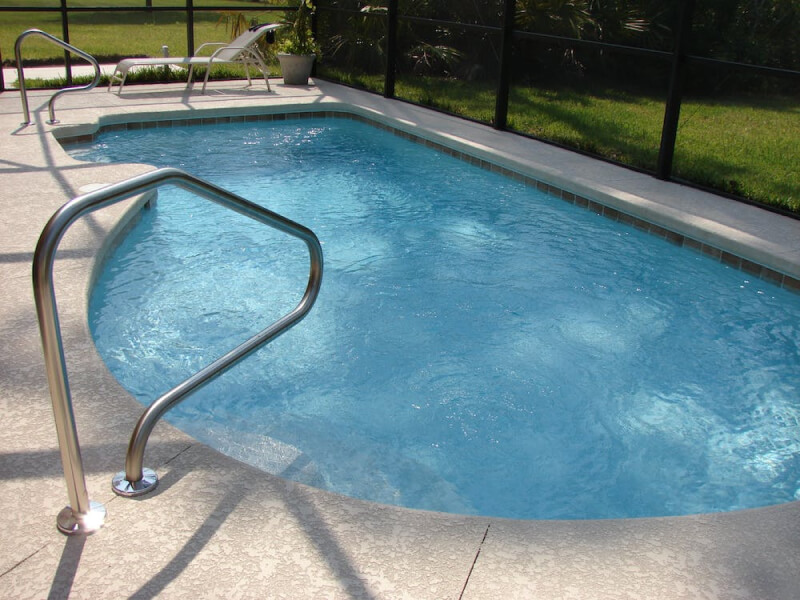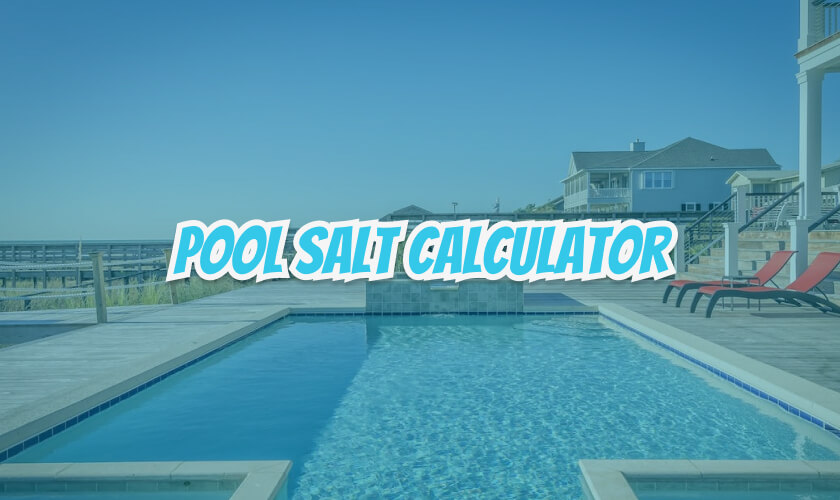If you’re a pool owner, maintaining the proper salt level in your pool is crucial for optimal water quality and balance. But figuring out the right amount of pool salt to add can sometimes be a confusing task. That’s where a pool salt calculator comes in handy. With a pool salt calculator, you can easily determine the precise amount of salt needed to achieve the desired salinity level in your pool.
Using a pool salt calculator is quite simple. You’ll need to input a few key details such as the current water volume of your pool, the target salinity level you want to achieve, and the brand of salt you’re using. The calculator will then calculate the exact amount of salt you’ll need to add to your pool. This takes the guesswork out of the equation and ensures that you’re adding the right amount of salt for optimal water balance.
Not only does using a pool salt calculator save you time and effort, but it also helps you avoid over or under salting your pool. This is important because an incorrect salt balance can lead to a host of issues such as corrosion of pool equipment or irritating the skin and eyes of swimmers. So, if you want to maintain crystal clear water in your pool without the hassle of manual calculations, a pool salt calculator is a must-have tool in your pool maintenance arsenal.
Why Use a Pool Salt Calculator?

Making sure your pool has the right balance of salt is crucial for maintaining its overall health and performance. However, determining the correct amount of salt to add can be a bit perplexing. This is where a pool salt calculator comes in handy. Here are a few reasons why using a pool salt calculator can greatly benefit you:
1. Accurate Salt Measurement
A pool salt calculator takes the guesswork out of determining the optimal amount of salt needed for your pool. By inputting essential information such as pool volume and current salt level, the calculator provides you with precise measurements. This ensures that you neither under-salt nor oversalt your pool, both of which can have negative effects on your pool’s chemistry.
2. Time Saving
Calculating the required amount of salt manually can be time-consuming and tedious. With a pool salt calculator, all you need to do is provide the necessary details, and the calculator will give you the exact quantity needed. This saves you valuable time and effort that can be better utilized for other pool maintenance tasks.
3. Cost Effective
Adding the right amount of salt not only ensures a healthy pool, but it also helps you save money. Adding too much salt can result in excessive mineral buildup and potentially damage your pool equipment. On the other hand, adding too little salt could lead to ineffective chlorine production. By using a pool salt calculator, you can avoid these costly mistakes and maintain an optimal salt balance.
4. Consistent Water Quality
The salinity level of your pool water has a significant impact on its overall quality. When the salt concentration is too high or too low, it can affect the effectiveness of chlorine and hinder proper sanitization. By utilizing a pool salt calculator and maintaining the ideal salt level, you can ensure consistent water quality, leading to a more pleasant swimming experience.
In conclusion, incorporating a pool salt calculator into your pool maintenance routine provides numerous benefits. It helps you measure salt accurately, saves time, reduces costs, and ensures consistent water quality. By making use of this handy tool, you’ll be able to enjoy a healthy and well-balanced pool all season long.
Read Also: Pool Heater Cost: What You Need to Know Before Investing
How Does a Pool Salt Calculator Work?

A pool salt calculator is a valuable tool that helps you determine the amount of salt needed to achieve the ideal salinity levels in your swimming pool. This simple yet effective device takes various factors into account to provide you with accurate calculations.
Input Parameters
To use a pool salt calculator, you need to provide certain inputs related to your pool, such as its volume, current salt level, and target salinity. These parameters are essential to ensure precise results.
Salt Requirements
Once you input the necessary information, the pool salt calculator utilizes a mathematical formula to determine the exact amount of salt needed. The algorithm takes into account the pool volume, desired salinity level, and current salt concentration.
Conversion Factors
When working with a pool salt calculator, it’s important to understand the units of measurements being used. The calculator may require specific units in terms of volume (gallons or liters) and salinity (parts per million or percentage).
Calculations
The pool salt calculator performs complex calculations based on the input parameters and conversion factors. These calculations involve mathematical equations that consider the relationship between pool volume, target salinity, and current salt level.
Results
Once the calculations are complete, the pool salt calculator displays the precise amount of salt required to achieve the desired salinity level. It may also provide recommendations for adjusting the pool’s salt concentration based on the manufacturers’ guidelines.
Remember, a pool salt calculator is a helpful tool but not an absolute authority. It’s always recommended to consult with a pool professional or refer to your pool equipment’s user manual for additional guidance. By using a pool salt calculator, you can ensure that your pool water is properly balanced and maintained, providing a safe and enjoyable swimming experience.
| Input Parameters | Pool volume |
| Current salt level | |
| Target salinity | |
| Conversion Factors | Volume (gallons) |
| Salinity (ppm) | |
| Calculations | Mathematical formulas considering pool volume, target salinity, and current salt level |
| Results | Precise amount of salt required for desired salinity level |
| Recommendations for adjusting salt concentration based on manufacturers’ guidelines |
Factors to Consider Before Using a Pool Salt Calculator

When it comes to maintaining your pool, keeping the water balanced with the right amount of salt is crucial. A pool salt calculator can be a helpful tool in determining the correct amount of salt to add, but before you rely on it completely, there are a few factors you should consider:
1. Pool Size and Volume
The size of your pool and its total water volume will greatly impact the amount of salt needed. Before using a pool salt calculator, make sure you have accurate measurements of your pool’s size and volume. This will ensure that the calculations are as precise as possible.
2. Current Salt Levels
To accurately determine how much salt your pool needs, it’s important to know the current salt levels. You can easily test this using a pool salt testing kit or a digital salt meter. By knowing the starting point, you’ll be able to make more accurate adjustments using the calculator.
3. Salt Purity and Type
Not all pool salts are created equal. Different brands and types of salt can vary in their purity levels. It’s important to choose a high-quality salt that is specifically made for pool use. Be sure to check the purity of the salt and choose one that is suitable for your pool’s needs.
4. Water Temperature
Believe it or not, water temperature can affect the effectiveness of salt in your pool. Warmer water tends to dissolve salt more quickly, which may require additional salt to be added. Take into consideration the average temperature of your pool water when using the calculator.
5. Manufacturer Recommendations
Each pool manufacturer may have their own guidelines and recommendations for salt levels. It’s important to consult the manufacturer’s instructions to ensure you’re within the recommended range. This will help maintain the longevity of your pool equipment and prevent any potential damage.
6. Environmental Factors
Consider the environmental factors that could affect your pool’s salt levels. Factors such as rain, evaporation, and bather load can impact the salt levels over time. Keep these factors in mind and make periodic adjustments to maintain the proper balance.
By taking these factors into consideration before using a pool salt calculator, you’ll be better equipped to maintain your pool’s salt levels accurately and efficiently. Remember, a healthy and well-balanced pool leads to a more enjoyable swimming experience for you and your family.
Read Also: Above Ground Pool with Decking Cost: The Ultimate Guide
Calculating the Ideal Pool Salt Level

Maintaining the ideal salt level in your pool is crucial for ensuring a clean and safe swimming environment. Too little salt can compromise the effectiveness of your pool’s chlorine generator, while too much salt can cause damage to pool equipment and make the water unsuitable for swimming. To achieve the perfect balance, you need to calculate the ideal pool salt level, and this section will guide you through the process.
Determine the required salt level
The first step is to check the manufacturer’s recommendations for your specific chlorine generator. It will typically provide a recommended salt level range, expressed in parts per million (ppm). This is the target salt level you need to achieve in your pool.
Measure your current salt level
Use a reliable salt test kit to measure the salt level in your pool. Follow the instructions provided with the test kit to obtain an accurate reading. Make sure to take multiple measurements in different areas of the pool to ensure consistency.
Calculate the salt adjustment needed
To calculate the required salt adjustment, subtract the current salt level from the target salt level. For example, if your target salt level is 3000 ppm and your current salt level is 2500 ppm, you need to add 500 ppm of salt to the pool.
Determine the pool’s water volume
To determine the amount of salt to add, you need to know the volume of water in your pool. You can use a pool water calculator or consult your pool’s documentation to find the water volume. Once you have this information, you’re ready to calculate the amount of salt needed.
Use a pool salt calculator
There are several online pool salt calculators available that can help you determine the amount of salt required based on your pool’s water volume and the required salt adjustment. Simply enter the values into the calculator, and it will provide you with the precise amount of salt to add.
Add salt gradually
It’s important to add salt to your pool gradually to avoid overshooting the target salt level. Distribute the salt evenly across the pool’s surface and allow it to dissolve completely before retesting the salt level. This will ensure accurate readings and prevent any potential damage.
By following these steps and using a pool salt calculator, you can easily calculate and maintain the ideal salt level in your pool. Remember to regularly test the salt level and make any necessary adjustments to ensure a clean and enjoyable swimming experience.
Read Also: A Guide to Store Your Pool Chemicals Properly
How to Use a Pool Salt Calculator

A pool salt calculator is a handy tool that can help you determine the right amount of salt to add to your swimming pool. By using a pool salt calculator, you can ensure that your pool water is properly balanced, which is essential for maintaining water clarity and swimmer comfort. Here’s a step-by-step guide on how to use a pool salt calculator effectively:
Gather the Necessary Information
Before using a pool salt calculator, you’ll need to know your pool’s current salt level, the desired salt level, and the volume of your pool in gallons. You can obtain the current salt level using a salt test kit, and the desired salt level can be determined based on your personal preference or manufacturer recommendations.
Find a Reliable Pool Salt Calculator
There are several pool salt calculators available online, and it’s important to choose a reputable and accurate one. Look for calculators that take into account factors such as pool volume, desired salt level, and current salt level to provide precise salt dosage recommendations.
Input the Required Information
Once you’ve found a suitable pool salt calculator, enter the necessary information into the designated fields. Make sure to select the appropriate units of measurement, such as gallons for pool volume and parts per million (ppm) for salt levels.
Generate the Salt Dosage Recommendation
After submitting the required information, the pool salt calculator will generate a salt dosage recommendation. This recommendation will typically be expressed in pounds or kilograms of salt to be added to the pool.
Follow the Recommended Dosage
With the salt dosage recommendation in hand, carefully measure and add the recommended amount of salt to your pool. It’s essential to follow the recommended dosage to avoid over or under-salting your pool, which can lead to imbalanced water chemistry.
Test and Adjust
After adding the recommended amount of salt, allow the pool water to circulate for a few hours before retesting the salt level. Use a salt test kit to measure the salt level and compare it to the desired range. If needed, make additional salt adjustments following the same process until the desired salt level is achieved.
Using a pool salt calculator takes the guesswork out of salting your pool and ensures that you achieve the ideal salt level. By regularly monitoring and maintaining the proper salt level, you can enjoy crystal clear water and a more comfortable swimming experience. So, take advantage of this valuable tool and keep your pool water in perfect balance!
Read Also: Best Pool Pump Timer to Buy – Save Your Electricity Bill!
Maintaining the Recommended Pool Salt Level

To ensure your pool stays clean and safe for swimming, it’s important to maintain the recommended salt level. This will not only enhance the effectiveness of your pool’s sanitization system but also extend the life of your equipment. Here are a few tips to help you maintain the optimal pool salt level:
1. Measure the Salt Level Regularly
Use a pool salt calculator or a salt testing kit to monitor the salt level in your pool. Aim to keep it within the recommended range, typically between 2700 and 3400 parts per million (ppm). Testing should be done at least once a week to ensure accuracy.
2. Add Salt as Needed
If the test results show a low salt level, it’s time to add more. Refer to the pool salt calculator or consult the manufacturer’s guidelines for the appropriate amount of salt to add based on your pool’s size. Remember to spread the salt evenly around your pool for proper distribution.
3. Consider Environmental Factors
Factors such as rainfall, evaporation, and bather load can affect the salt level in your pool. Higher temperatures and heavy rain can dilute the salt concentration, while increased bather load may require additional salt to maintain the desired level. Keep these factors in mind and adjust accordingly.
4. Check Water Balance
In addition to monitoring the salt level, it’s crucial to regularly test and balance the other chemical parameters of your pool water, such as pH and alkalinity. Imbalanced water chemistry can impact the effectiveness of your sanitization system and compromise swimmer comfort and safety.
5. Regularly Clean the Salt Cell
The salt cell is a vital component of saltwater pools, responsible for converting salt into chlorine through the process of electrolysis. Over time, scale and mineral deposits can accumulate on the cell, reducing its efficiency. Follow the manufacturer’s instructions to clean the cell regularly, usually every three to six months.
6. Schedule Professional Maintenance
While regular testing and maintenance can go a long way in ensuring the optimal salt level, it’s also advisable to schedule professional pool maintenance at least once a year. This will help detect any underlying issues and ensure your pool remains in peak condition.
By following these guidelines and maintaining the recommended pool salt level, you can enjoy a clean, safe, and inviting pool all season long.
Conclusion
In this article, we’ve explored the importance of using a pool salt calculator to maintain the right balance of chemicals in your pool. By accurately calculating the amount of salt needed, you can ensure that your pool remains clean, safe, and enjoyable for swimming.
By utilizing a pool salt calculator and maintaining the appropriate salt levels, you can enjoy a crystal-clear pool that’s both safe and enjoyable for everyone. Remember to regularly check and adjust the salt levels as needed, and consult with a professional if you have any concerns or questions about your pool maintenance routine.
That concludes our article on pool salt calculators. We hope this information has been helpful in guiding you towards maintaining a clean and well-balanced pool. Happy swimming!
